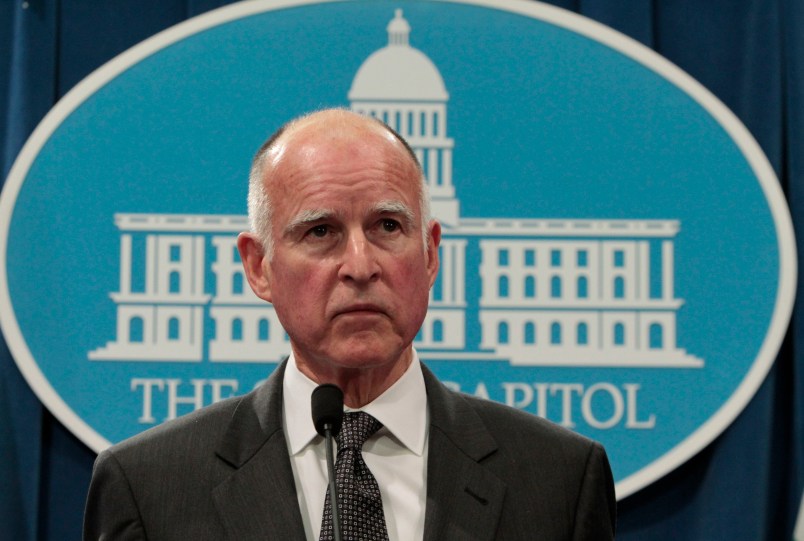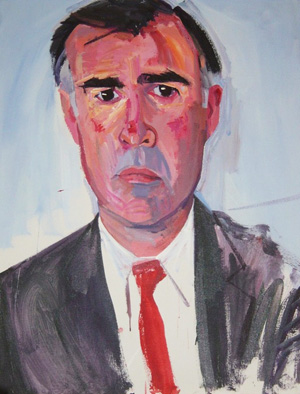Late last night I saw this Twitter video clip of Gov. Jerry Brown (D-CA) leaving the governor’s office (presumably?) for the last time as Governor of California. It made me consider his remarkable and uncanny public career and my own memories of it, which now stretch over the course of a lifetime.
? @JerryBrownGov departs the Governor’s Office (with some help from Cali and @ColusaBrown) pic.twitter.com/Euoa7A17fM
— Gov. Brown Press Office (@GovPressOffice) January 7, 2019
Edmund Gerald “Jerry” Brown, Jr. was sworn in as Governor of California in January 1975, about six months before my family moved to California in the summer of that year. He managed this feat at the remarkably young age of 36, taking over from Ronald Reagan and doing so, in no small part because his father, Edmund G. “Pat” Brown had been Governor from 1959 to 1967. Brown then had the audacity to turn around and immediately run for President in 1976 and then again in 1980.
As a young boy with hippie-ish parents newly moved to the state, Brown represented all the liberal and counter-culturish dimensions of our new home. I knew that he slept on a foam mattress in a private apartment, rather than living in the governor’s mansion, and that he dated Linda Ronstadt. As I got older and learned more about politics I discovered that Brown’s political legacy was considerably more complex, idiosyncratic and inconstant than all that. But that was the world I lived in at the time.
In his second term, Brown was saddled with a right-wing Lt. Gov., Mike Curb, who partly chained him to the state by threatening to override his policies when and if Brown left the state. Brown seemed increasingly out of place and out of time in his second term, especially when his predecessor as governor, Ronald Reagan, was elected President in 1980. This impression of a man of the past was cemented when Brown was defeated in his run for the Senate by then-San Diego Mayor Pete Wilson in 1982.
For me and for many, Brown’s tenure as Governor was summed up by his official portrait that debuted in 1984, two years after he left office.
It is probably the only memorable work of official portraiture, the only work of quality and significance I can think of until Kehinde Wiley’s official portrait of Barack Obama was released in 2018. It was also an indifferent “fuck you” to all the canons of the form, especially in 1984, the high tide of Reaganism. (The painting is the work of Don Barchardy, also known as the longtime partner of novelist Christopher Isherwood, who died in 1986.)
California has a long progressive tradition going back to the early 20th century. But from the vantage point of today, when California is the national anchor of Democratic and progressive politics, it can be difficult to remember just how critical a state it was to the late 20th century national Republican political hegemony. From 1952 to 1988, Republicans won the state in every election except for 1964. California launched the careers of Richard Nixon and Ronald Reagan. It also passed Proposition 13 in 1978, the bellwether of the national anti-tax movement which has dominated national politics for two generations. Brown, bizarrely, at first campaigned against Prop 13 and then switched positions and campaigned for it.
After the 1982 defeat Brown basically disappeared from public life until 1988 when he announced he was running to become Chairman of the State Democratic party. His reemergence came with a string of newspaper reports about how Brown had been in Japan studying Zen Buddhism and in Calcutta with Mother Theresa.
Here from the LA Times on January 23rd, 1988 …
Former California Gov. Edmund G. Brown Jr., who was in Japan last year studying Zen Buddhism, is now in Calcutta working as a volunteer in Mother Teresa’s Missionaries of Charity Home for the dying and destitute.
“I have always been impressed with Mother Teresa and her works,” Brown told a reporter Friday by telephone. “Now that I have the time, I wanted to come here and see for myself.”
Brown said he has been in Calcutta for a week and plans to stay at least two more.
“The people here are wonderful,” he said, “volunteers from all over the world. They are all extraordinary.”
Brown’s duties at the home include bathing and otherwise comforting the patients, many of whom are dying of malnutrition.
Brown was elected Chair of the state party. Then he resigned to run for Senate, before deciding not to run for senate. Then he ran for President a third time in 1992. Ever the protean figure reinventing himself, in this race he would often introduce himself in cities like Boston and New York and in the post-Industrial Midwest as “an Irish politician from California.” His main role in that race was as Bill Clinton’s losing but barbed antagonist as an advocate of a 13% national flat tax. (He’d allied himself with supply-side gadfly Jude Wanniski.)
Here Brown disappears again, somewhat ignominiously, only to remerge at the end of the decade with what is likely his most audacious reinvention: as a normal politician who runs for office more or less on his own merits, governs and then runs again on a record. In late midlife he begins what is, if you set aside everything that came before it, an almost conventional political career. Brown was elected Mayor of Oakland in 1998, a job without an obvious political future, seeming to some as a kind of penance of sorts. He was reelected in 2002. He was elected Attorney General in 2006 and then to two successive terms as governor in 2010 and 2014.
Throughout his second tenure, Brown has presided over what is by almost any definition the most Democratic and progressive major state government in the United States, while also being the largest. But he’s done so with spending-skeptic side he retains from his first run in 1970s. Indeed last month he was telling reporters he doubts his successor will be able to restrain lawmakers’ appetite for new programs and spending. “I’d say we’re in for contentious times and for too many rules, too many constricting mandates and probably too much spending.” He is like a sometimes churlish older brother overseeing the progressive millennium.
Brown has not only had a successful two terms as governor. He’s maintained high political approval throughout his second two terms as governor and been the dominant force politically in a state in which the Republican party all but no longer exists. It is impossible not to conclude that Brown was a far more able governor in his 70s than he was in his 30s.
Brown turned 80 last April. He and his wife are moving to a ranch in rural Colusa County, population 21,000.







